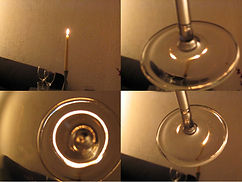

The Concentration-Mass Relation
Studies on simulated c-M relation are abundant. All point out to a slight decrease of the concentration on dependence of the mass of the system. The physical and cosmological justification is linked to the hierarchical scenario of structure formation: small halos form at earlier time when the universe was denser than today and, over time, the sedimentation of material at the center happens in an already-established high-density peak.
In the last decade, with the assemblage of significant observational sample, the c-M relation has been measured from X-ray and optical data. My recent work emphasizes the importance of comparing observational data with theoretical predictions from samples obtained using observational selection criteria.
References:

Gravitational lensing

The Mass Biases
X-ray observations allow the cluster mass profiles to be derived by assuming that these systems are spherically symmetric and that the emitting gas is in hydrostatic equilibrium
Optical observations are used for gravitational lensing studies. Cluster matter distorts background-galaxy images. Strong distortions occur in the cores of some massive galaxy clusters. Weak distortions are impressed on the shape of distant galaxies that lie on the sky at large angular distances from the cluster centers.
The techniques based on the X-ray and lensing observations are affected by different biases that we investigated by means of numerical simulations.
Most clusters are still forming and the presence of residual gas motion slows down the approach to the equilibrium state. An extra term, contributing to the cluster mass bias, is the X-ray temperature bias, present whenever the cluster has a complex temperature structure.
Gravitational lensing masses are instead affected by presencce of substructures, interlopers or by the triaxiality of the systems.
References:
Cool Core Cluster From Cosmological Simulations
The description of the thermo-dynamical and chemical properties of the central regions of clusters had been a long standing challenge for simulators. Without any exception, cosmological simulations produced cores with a peak in metal enrichment and a high entropy level. In other words, numerical models have always failed to reproduce what has been observed: real clusters can be classified as cool-core clusters (with low entropy and high central metallicity) and non-cool core clusters (with high entropy and low central metallicity).
This theoretical stand off was broken from our numerical group in Trieste in collaboration with the group of Klaus Dolag in Munich. In a Letter, appeared in The Astrophysical Journal (2015, APJ, 813, L17) and titled "Cool Core Clusters from Cosmological Simulations", we presented the new simulations enriched by a detailed model of feedback from the accretion into a black hole and by a new hydrodynamical scheme.
Please, read the full new in the OATS webpages.
References:

Comparison between the theoretical results for Cool Clusters, green, and for Non-Cool Clusters, red, and the profiles obtained from X-ray data of the Chandra and XMM-Newton satellites. The analysis of the data is of Pratt et al. 2010, A&A, 511, A85 and Ettori et al. 2015, A&A, 578, A46.